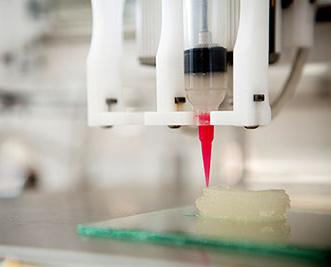Not to be confused with the types of activities engaged in by scientists working for the Kleenex® company, people who are tissue engineers closely study the cells, scaffolding, and processes necessary to grow new connective tissues or organs for human implantation. The field emerged in the mid-1980s and has been advancing by leaps and bounds ever since.
The cells in the human body, with the exception of blood cells, require some sort of anchor point. That environment is referred to as the ExtraCellular Matrix (ECM) and is a complex construction involving multiple components and tissue-specific compositions. Tissue engineers have spent a great deal of time and effort working on the development of the biological substitutes for restoration, replacement, or regeneration of missing or defective tissues. The ECM that provides the scaffolding for the growth of these cells is therefore an important aspect of advancing the  suitability of these engineered tissues.
suitability of these engineered tissues.
The particular nature of ECM construction has led to the search for an ideal biomaterial for the creation of the scaffolding. Specifically, the four areas of interest are the ability to (1) facilitate the integration of the host tissue once it has been implanted through the use of distributed void volume, (2) be compatible with the various cellular components of the tissue, (3) include biological cues or be otherwise bioactive, and (4) provide structure and support to enhance the mechanical and shape stability of the growing tissue.
It is within this context that researchers at the Institute of Genetic Medicine at Newcastle University and the School of Chemistry, Food and Pharmacy at the University of Reading undertook the investigation they have recently published in the Journal of Tissue Engineering. Their findings are reported in a paper entitled “New Self-Assembling Multifuctional Templates for the Biofabrication and Controlled Self-Release of Cultured Tissue.”
Many of the more recent efforts to fabricate tissues have focused on the creation of a scaffold-free environment in which tissue could be grown. In addition, emphasis has been placed on novel approaches to ease the detachment of the new cells from the scaffolding itself. However, the research in this area has, thus far, focused on the creation of sheets of cells rather than on control over cell hierarchy and structure. It was time to address this challenge.
As the researchers noted in their article:
“Biologically interactive implants are gaining considerable interest within the materials science community. Thus, new methodologies are required that can be easily incorporated into future transplantable medical devices capable of directing cell and tissue formation.”
The logical next step would be to pair this research with that done by Chinese researchers and published in the most recent issue of the Journal of Biofabrication, entitled “Three Dimensional Printing of Hela Cells for Cervical Tumor Model in Vitro.” In this article, researchers describe the use of a 3D cell printer that they have developed that enables them to directly assemble cells and the ECM at the same time. This simultaneous creation leaves a scaffolding that can be directly integrated into the body, thus removing the issue created by the use of a non-implantable scaffolding structure.
People in the world of 3D printing most likely immediately found the characteristics necessary to consider for ECM scaffolding creation triggering memories from a number of stories regarding knee and hip replacements that have demonstrated the ability of biofabricated 3D prints to be integrated into a human recipient. And, in fact, over a decade ago, researchers from the Department of Bioengineering at Clemson University recognized the potential for the design of custom scaffolds through 3D design.
Since then, there have been a growing number of instances of the successful combination of biomedical needs and 3D printing possibilities. The development by the UK researchers of the material that is necessary for creating this combined cell and ECM print is the next step in the perfection of integrated 3D printing processes for tissue engineers.
Discuss these findings in the Tissue Research forum thread over at 3DPB.com.
Subscribe to Our Email Newsletter
Stay up-to-date on all the latest news from the 3D printing industry and receive information and offers from third party vendors.
You May Also Like
3D Printing Unpeeled: New Arkema Material for HP, Saddle and Macro MEMS
A new Arkema material for MJF is said to reduce costs per part by up to 25% and have an 85% reusability ratio. HP 3D HR PA 12 S has been...
3D Printing News Briefs, January 20, 2024: FDM, LPBF, Underwater 3D Printer, Racing, & More
We’re starting off with a process certification in today’s 3D Printing News Briefs, and then moving on to research about solute trapping, laser powder bed fusion, and then moving on...
3D Printing Webinar and Event Roundup: December 3, 2023
We’ve got plenty of events and webinars coming up for you this week! Quickparts is having a Manufacturing Roadshow, America Makes is holding a Member Town Hall, Stratafest makes two...
Formnext 2023 Day Three: Slam Dunk
I’m high—high on trade show. I’ve met numerous new faces and reconnected with old friends, creating an absolutely wonderful atmosphere. The excitement is palpable over several emerging developments. The high...


































